
It never ceases to amaze me how much bad information is still quite accepted in the dog world. Despite all the books that have been written on the subject, despite all the advances that have been made in the science of dog training, there are some statements still so widely accepted as fact, that by accepting them we are really doing a disservice to our dogs. Some statements come in the form of advice, some in the form of tips and techniques, others with warnings to “never do this”. Any dog trainer with a small amount of experience has heard these expressed many MANY times.
I thought I would present some of the myths here and finally, at least for those reading this blog, put them to rest once a for all.
So ladies and gentleman, I present to you…(cue the trumpets)
Dog Training Advice You Can Totally Ignore.

- The Apology: “My Dog Sleeps on the Bed/Furniture”:
This one is presented to me all of the time in classes and on home consultations.
It usually comes in the form of,
“We let our dog sleep on the bed, I know that is not a good thing but we love it so much”
So let’s make this perfectly clear…if you want your dog to sleep on the bed with you…do it. If you do not mind the hair, waking up doing an impresonation of a pretzel and the occasional cold nose to the butt in the morning…let your dog sleep in the bed with you. It will not ruin your dog. It does not mean your dog is “alpha” to you.
Your dog will not magically develop behavioural issues because your dog is sleeping in your bed.
I see some may be saying now:
“But what about being Alpha?”
“How is the dog supposed to know his place?”
If you have a problem with your dog growling at you when you try to move them on the bed, growling at your significant other when he or she gets into the bed, growling at your kids when they get onto the bed…that is a different issue. The same goes for couches and furniture. If that is the case, your dog is displaying some resource guarding. That needs to be dealt with. These issues were not created by allowing your dog on the couch, bed or furniture. They are a sign of a larger issue and one of the ways the issue is not being dealt with is that you are continuing to allow your dog on these things even after your dog choose to growl, snap, bite at you.
Again, these are two very different things.
If your dog is not displaying any negative behaviour, likes snoozing away on your bed, your couch, the chair and you do not mind it…enjoy it. Sook your dog all you wish.
Just stop apologizing and feeling guilty for it. There is no need.

2. Advice: “You Must Always Walk Through Doors First”
Where the idea came from that you have to go into every room, go through every door, and every gate first in order to lay claim to the area beyond it or show your dog that you are boss is just silly.
I can understand if you are worried about being knocked over, if your dog charges the street, visitors to your house, and the mailman. If you want to teach your dog to pause and politely go through an entry and exit in this case then the whole routine has merit. You want to teach your dog some manners. However, enforcing this rule just because it is supposed to show the dog that you are boss is just plain dumb. It serves no purpose except to be some arbitrary nonesense rule.
If you are doubting me, think about guide dogs for the visually impaired. Those dogs lead their owners EVERYWHERE. Do you think any of them are actually trying to “increase their position in the pack hierarchy”?
Nope, they are simply doing their job and are happily doing so.
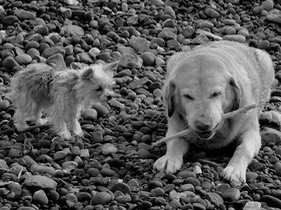
3. Engage in Preventative Training: “Randomly Put Your Hands In Your Dog’s Bowl When He Is Eating”:
For the love of all that is holy…please stop this practice.
The defence I hear the most for engaging in this type of training is that it is supposed to prevent resource guarding. The idea being if you place your hands in your dog’s bowl, randomly take away your dog’s food and give it back early and often, the dog will be less defensive over their food thus preventing bites and resource guarding.
This idea is absurd.
Randomly taking the food bowl away from your dog only teaches your dog that you are a bully. It can be counter productive and actually cause resource guarding to form.
Doubting this? Think about it by using the following analogy…
If you were eating and somebody approached you, prevented you from eating by sticking his hands in your food, would you be happy about it? If, when you expressed your displeasure, the person randomly took your food away from you, would not make you relax?
No, you would loose your mind. It is not a fun game, it would frustrate you AND WORST OF ALL, there is nothing you could do or say to change the outcome as it is an unfair activity in the first place.
Think about it…go ahead…it is no different for your dog.
If this is something you are worried about and you wish to do some preventative work, offer some incentive to your dog for engaging with you. Start calling your dog’s name at a young age when he is eating. When he looks up from his bowl, move the bowl while giving him a higher reward treat, giving lots of praise and immediately returning his bowl. Sit by your dog’s bowl with his food in your hand. Put some in his bowl and allow him to eat it. When he is finished that portion, have him sit and put another portion in the bowl.
Engaging in this type of work shows your dog that you are not being a bully. Good things happen when you come around his bowl. When he allows his food to be handled, he gets an even bigger reward and his food is immediately returned.
Make sense?
So please, stop sticking your hands in your dog’s bowl when he is eating. Stop randomly taking your dog’s food away. Let’s toss this one in the junk pile once and for all.
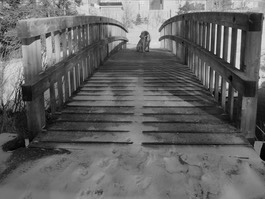
4. Tip: “Use a Squirt Bottle/Rolled Up News Paper To Eliminate a Behaviour”:
Please do not do this.
It is so old school it is barely worth discussing yet the idea is still sadly prevalent. Even sadder is most people know the difference. Most will admit they only did this because “nothing else worked”
Defenders of these practices usually claim a squirt of water in a dog’s face causes no harm or a rolled up news paper to the snout does not hurt. This is usually followed by “I do not know if it was good or not to do this but it worked for me”
These methods are based on negative consequences.
They “CAN” work.
BUT (and you knew there was a BUT coming) they have a much higher possibility of backfiring on you.
There are so many better alternatives to eliminating behaviours. The alternatives are more effective, easer for dogs to understand and do not involve the use of any negative responses. The beauty about not using negative responses is that usually the behavioral change is longer lasting, more permanent and your dog learns much more quickly the new desired behaviour. It is a win win for both you and your dog.
If you wish to use a newspaper or water pistol…use it on yourself. You will get much better end results.
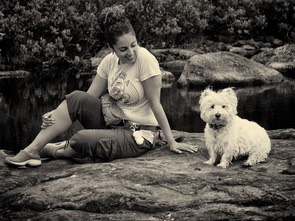
5. Technique: “Using a Deep Voice to Get Your Dog to Obey”:
This one comes up all of the time, especially in class.
It is usually stated by a female and involves a claim like “My dog listens to my husband/boyfriend better than me because he has a deeper/sterner voice than mine”
Lets make things clear, shouting, screaming, yelling will not make your dog listen to you better. If using your voice like this results in your dog doing what you are telling them to do, most times you have just scared your dog into a default position such as a sit or down. Your dog is not looking at you guiltily because they know they were not obeying you. Your dog is looking at you with his head down because he thinks you are angry and he does not know why.
Your dog is not really listening to you any better, your dog is just scared to do anything else.
Personally I think this is a real disservice to your dog.
Truth is, you can go completely non verbal and still have your dog listen to you quite effectively if you have good communication with your dog.
The secret is developing PROPER communication, not adjusting your voice to lower, deeper, sterner levels.
A good quality obedience class is invaluable in this regard. It will show you how to open up those lines of communication and achieve the success you are looking for.
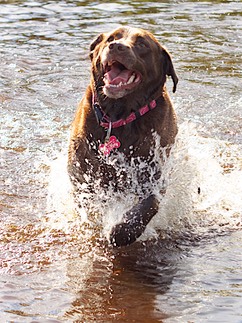
6. Warning: “Bringing Hunting Dogs Into the Home Spoils Their Hunting Instincts”:
I cringe any time I hear people use this sad reasoning in defence of keeping their dogs in outside pens and kennels.
It is usually followed by an explanation of how your family had hunting dogs all your life and they never came inside…if it was ok then, it is ok now.
Lets examine this critically for a minute
Our families used to feed babies carnation milk, we slept in lead painted beds, rode in the back of pickup trucks, seat belts were a suggestion, and smoking was good for you. Get the idea?
Just because these were common practices years ago does not mean they were smart practices.
Your dog will be no better at tracking and hunting if left deprived of human attention. It will however develop all kinds of other issues, none of which are positive.
What will improve the tracking and hunting skills of any dog is spending time with your dog, interacting with your dog, teaching him the skills needed and developing proper communication. Some of the best hunting dogs I know are also totally spoiled and loved house pets.
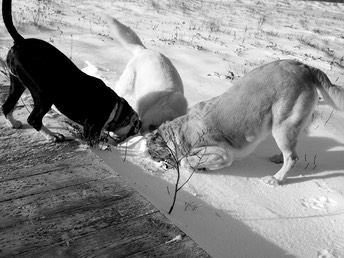
7. Sage Advice: “Just Let Them Work It Out”:
This one really concerns me.
The idea being that if you have a couple of dogs, a dog and a cat or whatever combination, that they should just work out whatever difficulties they are having.
Allow the dog to chase the cat. Once the dog gets a swat, he will learn the cat is off limits. Allow the dogs to fight it out, it is a lot of bluster but they will establish proper interaction. They will learn who is dominant.
While all of this COULD happen, there is a greater likelihood that damage will be done.
The dog could just as easily maul the cat, the cat could easily hook the dog’s eye out, the dogs could easily turn on each other for real. The potential for harm in this case is too great.
Also in allowing them "to work it out", it totally destroy’s the other animal’s trust in you. It teaches the offending party that you are neutral to what is happening. The cat learns that mom or dad will not interfere despite the dog bearing down on them. The dog that is being picked on learns that mom or dad does not care they are being picked on so they have to pick up for themselves. Imagine living in that kind of negative environment.
As an owner, you have a responsibility to teach your dog proper manners. Neglecting to do so and letting them figure it out is abdicating that responsibility, plain and simple. Don’t….JUST DON’T.
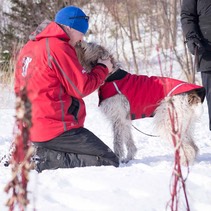
8. Old Faithful: “Never Play Tug of War”:
I still laugh when I see this one written anywhere or somebody presents it to me as FACT. It always comes with some warning expressing that tug will make your dog aggressive. It usually is backed up by a statement like:
“If cannot win the game each and every time, it can make your dog feel dominant to you”
or
“If you do engage in tug, you must ensure you win the game every time”.
This is utter balderdash (and yes I said balderdash, it relates to this type of thinking).
It is an old school view that goes hand in hand with most of the points discussed above. It based on dominance theory that needs to die the death it deserves.
Let’s make it clear…tug is a great game to play. It can be used as a tool to teach your dog so many useful skills. Tug is even more valuable if it is something that motivates your dog. A game of tug can teach a dog how to play nice, it can teach soft mouth skills, it can teach take it and leave it skills and can be an excellent reward for work well done.
If you are worried tug will teach bad habits. If you are worries that you “HAVE TO WIN” each and every time, this is quite easy to accomplish.
All you have to do to win is engage or not engage.
If your dog is being rude during the game, drop the toy and turn your back. You have instantly won. Yes, your dog has the toy but the toy is really not the point of the game. The point of the game is actually the act of playing. The dog will quickly realize what behaviour results in the game ending and what behaviour means that it continues. Think about it.
This can be an invaluable tool in your training toolbox.

This list is by no means exhaustive.
I have been a trainer for 9 years now and I still get these statements regularly presented to me.
For anybody out there wondering if a piece of advice they were given is quality or should be relegated to the garbage, I offer this simple explanation to you.
Forget about all the talk of dominance pack mentality being an alpha baloney you have been told and look at dog behaviour this way:
Dogs do something in order to get something
or to further explain that…
If a dog’s action gives him the desired reaction, he will continue committing the action. If his action does not get the desired reaction, he will move onto a different action in order to achieve the desired result.
Simple.
It is our responsibility as owners to respond appropriately with our reactions in order to shape the actions of our dogs. Open those lines of communication. When you do, you will find your dog is happier, listening more, you are getting less frustrated and having much more fun working with your dog.
For more on that topic, click HERE